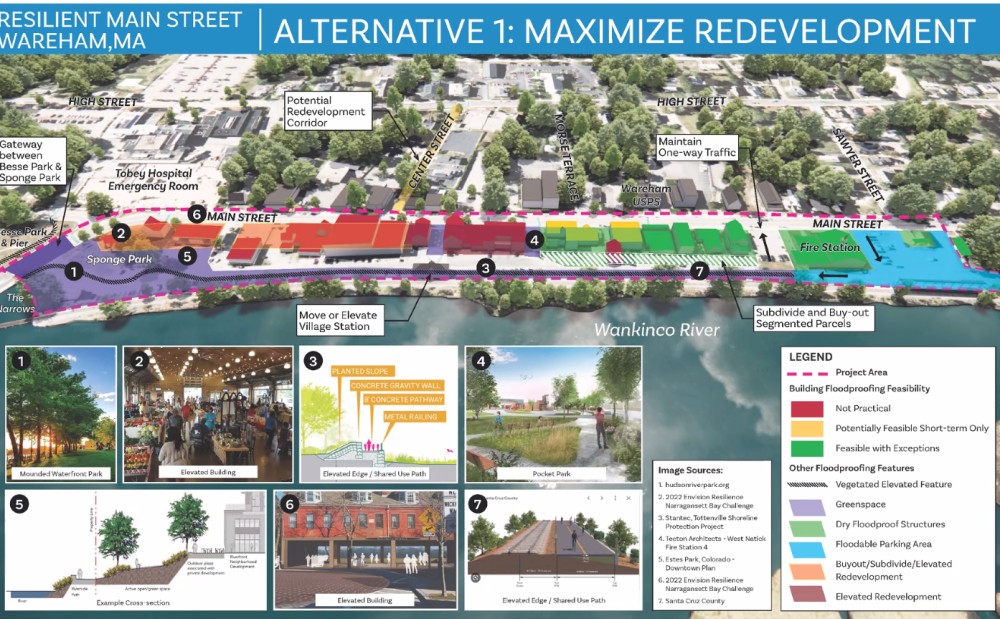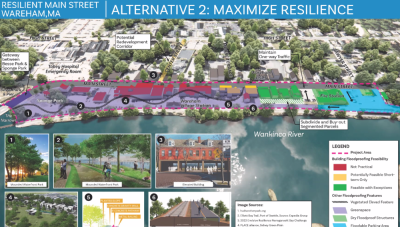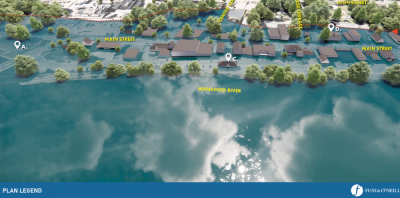Consultants float two designs for floodproofing downtown
During a Zoom meeting on Monday, April 3, the Fuss & O’Neill and Woods Hole Group consulting firms presented two floodproofing designs for Main Street and Merchants Way, representing two ends of the spectrum for Main Street’s future.
One design emphasized the economic redevelopment of Merchants Way, while the other focused on more long-term protection from flooding. The final design will likely end up somewhere in between, but the two design visions each have their own tradeoffs.
“We’re here tonight not to determine an end-all be-all decision,” said Chelsea Zakas, an environmental planner with Fuss & O’Neill. “We’re presenting all of this information to you… to show ideas to think about and to consider for the future.”
Wareham received a grant from the state in 2022 to develop a flood prevention plan for Main Street’s commercial district. That eventual plan will figure into the Wareham Redevelopment Authority’s urban renewal proposal.
Both alternatives presented by the consultants involve floodproofing some buildings and demolishing others, mainly on the southern end of Main Street. The “Maximize Resilience” design would not rebuild the demolished buildings. Instead, the design would relocate businesses to higher ground and turn the area near the water into green space which would absorb floodwaters.
Other floodproofing strategies included constructing a berm along the Wareham River and placing buildings on stilts.
The “Maximize Redevelopment” design would rebuild the demolished buildings.
In either case, the town cannot do anything about the railroad running alongside the Wareham River, because it is the property of the Massachusetts Department of Transportation.
Redevelopment Authority Chair Dan Butler said that the two alternatives are not mutually exclusive. Wareham could potentially implement the “Maximize Redevelopment” design, then switch to the “Maximize Resilience” design 20 or 30 years later.
The threat to Main Street’s commercial district is twofold, the consultants said. The sea is rising and storms are worsening due to climate change.
Woods Hole Group Senior Environmental Scientist Joe Famely compared the situation to “rolling a die over time that has fewer and fewer sides,” meaning that the chance of flooding will increase over time.
Serious flooding, he said, could occur as early as 2030.
“We’ve lucked out, to be frank, for a long time on the South Coast,” Famely said.
Even Hurricane Sandy was not as extreme as it could have been, given that it hit at low tide, Famely said.
Members of the public had the chance to comment about the two proposals.
Local resident Jeff Burrows asked how the project would be funded.
Fuss & O’Neill Senior Vice President Dean Audet said the funding for coastal resiliency projects is “rapidly expanding.”
“I’ve been doing this since the 1980s and never seen any funding like this,” Audet said.
Local resident Milly Burrows, speaking “as a taxpayer,” was worried that funding may not be plentiful forever.
“Wouldn't we want to sink our money and efforts into a longer-term solution from the get-go instead of throwing money away,” Burrows said, “because we know it’s gonna fail eventually, because we can’t hold the ocean back?”
Residents can give feedback on the two plans by filling out an online survey at tinyurl.com/ye2a3ubh.
The next step for Fuss & O’Neill and Woods Hole Group is to study whether the flood risk reduction is worth the cost of the projects. The consultants will then regroup and decide on a final design to recommend to the town.













